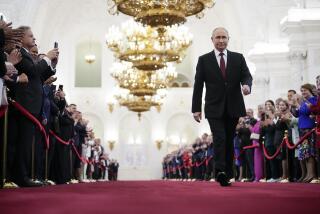SPECIAL EDITION: CRISIS IN THE KREMLIM : The March of Perestroika
Key events in Mikhail S. Gorbachev’s six years and five months as the leader of the Soviet Union: 1985
March 11: Mikhail S. Gorbachev, 54, is elected secretary general of the Soviet Communist Party following the death of Konstantin U. Chernenko, 73. He undertakes a reform of party structures.
July 2: Gorbachev replaces longtime Foreign Minister Andrei A. Gromyko with Eduard A. Shevardnadze, head of the Georgian republic’s Communist Party.
Oct. 15: Gorbachev presents a plan of economic restructuring, known as perestroika.
1986
March 6: The 27th Communist Party Congress votes for substantial changes in the party leadership.
Dec. 23: The dissident and Nobel Prize-winning physicist Andrei D. Sakharov returns to Moscow after seven years of internal exile at Gorky. Sakharov died Dec. 14, 1990.
1987
May 30: Defense Minister Sergei L. Sokolov is dismissed and replaced by Dmitri T. Yazov following the landing on Red Square of a Cessna light aircraft piloted by West German Mathias Rust.
Dec. 8: U.S.-Soviet treaty on the elimination of intermediate-range nuclear missiles (INF) is signed in Washington during the third Gorbachev summit with President Ronald Reagan.
1988
Feb. 28: Violent clashes between Armenians and Azerbaijanis at the Caspian Sea port of Sumgait spark a series of interethnic conflicts in the region involving minorities in Armenia, Azerbaijan and Georgia, with unrest spreading later to some central Asian republics.
May 18: Arrival of first convoy of troops withdrawn from Afghanistan. (Operation was completed Feb. 15, 1989.)
Oct. 1: Gorbachev is elected head of state as the bulk of the conservative Old Guard from the Leonid I. Brezhnev period (1964-82) is eliminated.
Dec. 1: Supreme Soviet adopts new constitution strengthening presidential powers.
Dec. 7: Addressing the U.N. General Assembly, Gorbachev announces pullout of 500,000 Soviet troops based in Eastern Europe.
1989
March 26: Free elections to the newly created Congress of People’s Deputies sweep out 20% of party leaders standing for election.
May 16: Gorbachev meets Deng Xiaoping in Beijing to normalize Sino-Soviet relations.
May 25: Gorbachev is granted a five-year mandate with enhanced powers.
July: About 200,000 miners in the Ukraine and Siberia strike.
July 6: Gorbachev envisages a “common European home” and scraps the “Brezhnev doctrine” of limited sovereignty for Eastern European states.
Dec. 1: Gorbachev and his wife, Raisa, are received by Pope John Paul II at the Vatican.
Dec. 2: The first summit between Gorbachev and President Bush following the upheavals in Eastern Europe effectively ends the Yalta postwar settlement.
1990
Jan. 15: State of emergency is declared in Caucasus after further ethnic clashes.
March 11: The Baltic republic of Lithuania declares independence.
March 14: Gorbachev is elected the head of a presidential system of government.
May 29: Radical reformer Boris N. Yeltsin is elected president of the Parliament of the Russian Federation.
July 10: Gorbachev is reelected party chief at the party’s 28th Congress.
Dec. 20: Foreign Minister Eduard A. Shevardnadze resigns and warns of a movement toward dictatorship.
1991
March 17: An all-Soviet referendum on the Union Treaty gives a 76.4% majority in favor of a “renewed Union of Soviet republics.”
June 17: Yeltsin is elected president of Russia by universal suffrage.
July 25-26: At Gorbachev’s prompting, a plenum of the Central Committee drops references to Marxism-Leninism in favor of social democratic principles.
Aug. 16: Gorbachev adviser Alexander N. Yakovlev, chief proponent of perestroika , resigns from the party and warns of an impending coup.
Aug. 19: Gorbachev is replaced as Soviet president in an apparent right-wing putsch.
SOURCE: Agence France-Presse
More to Read
Sign up for Essential California
The most important California stories and recommendations in your inbox every morning.
You may occasionally receive promotional content from the Los Angeles Times.









